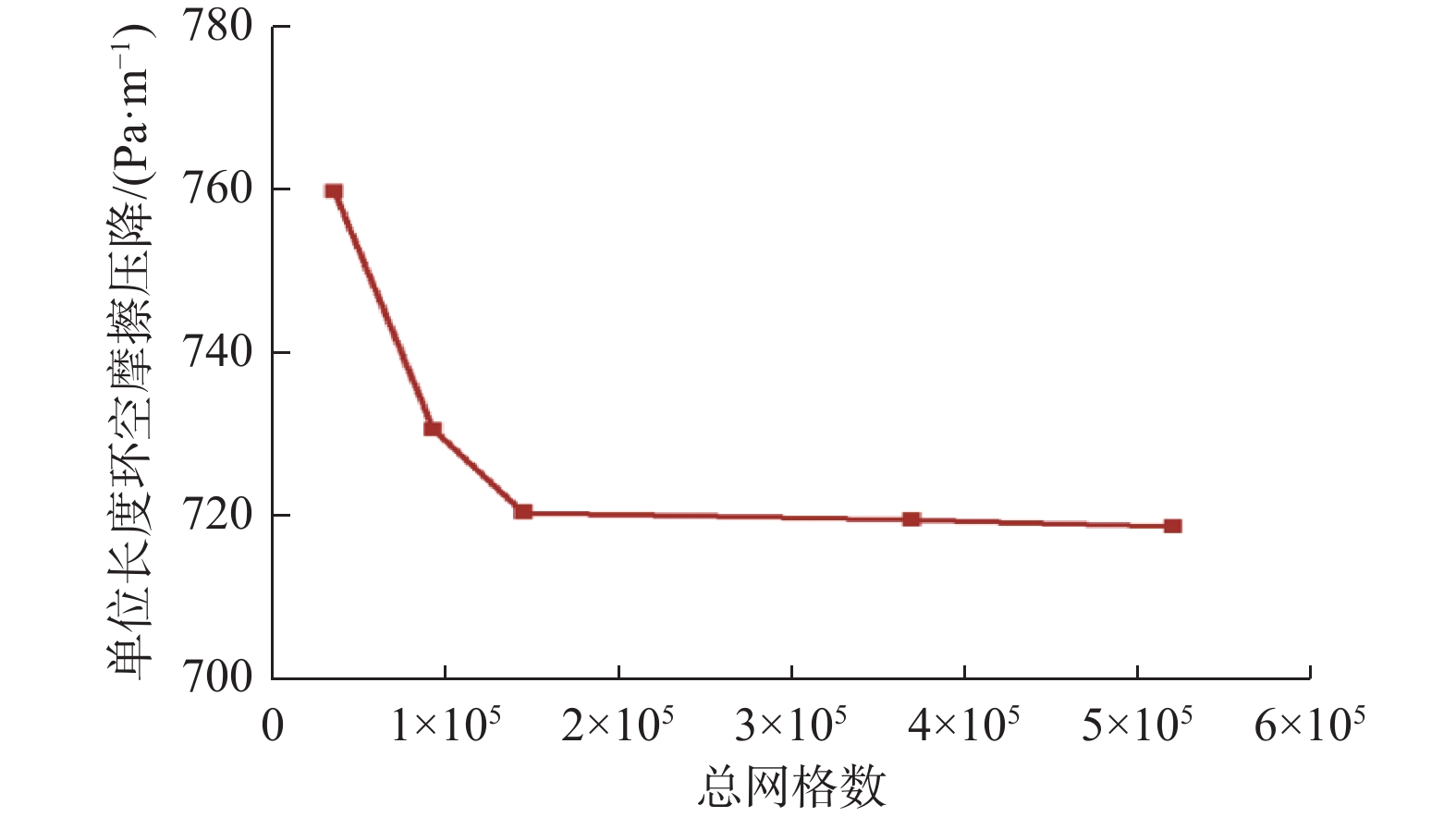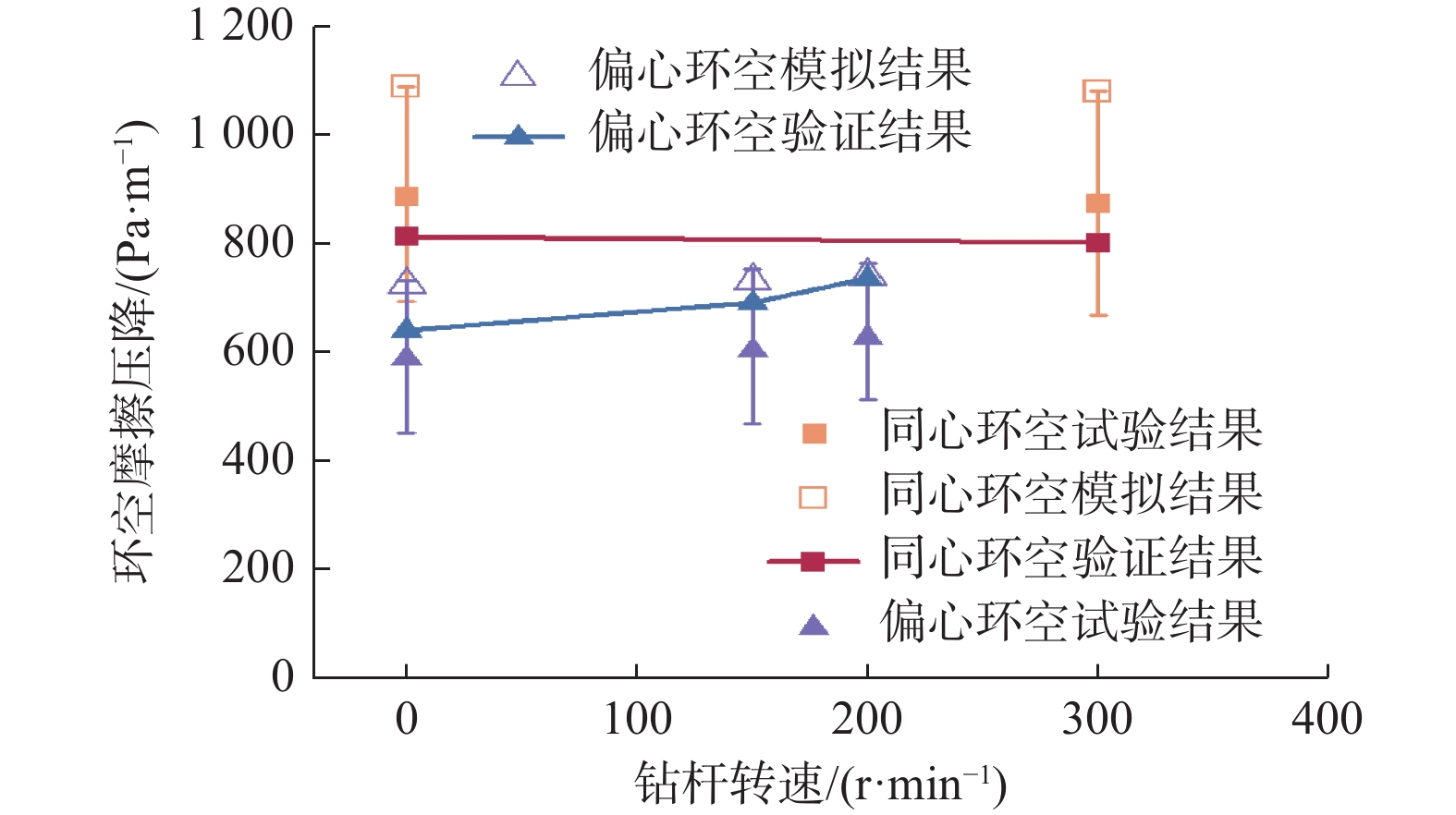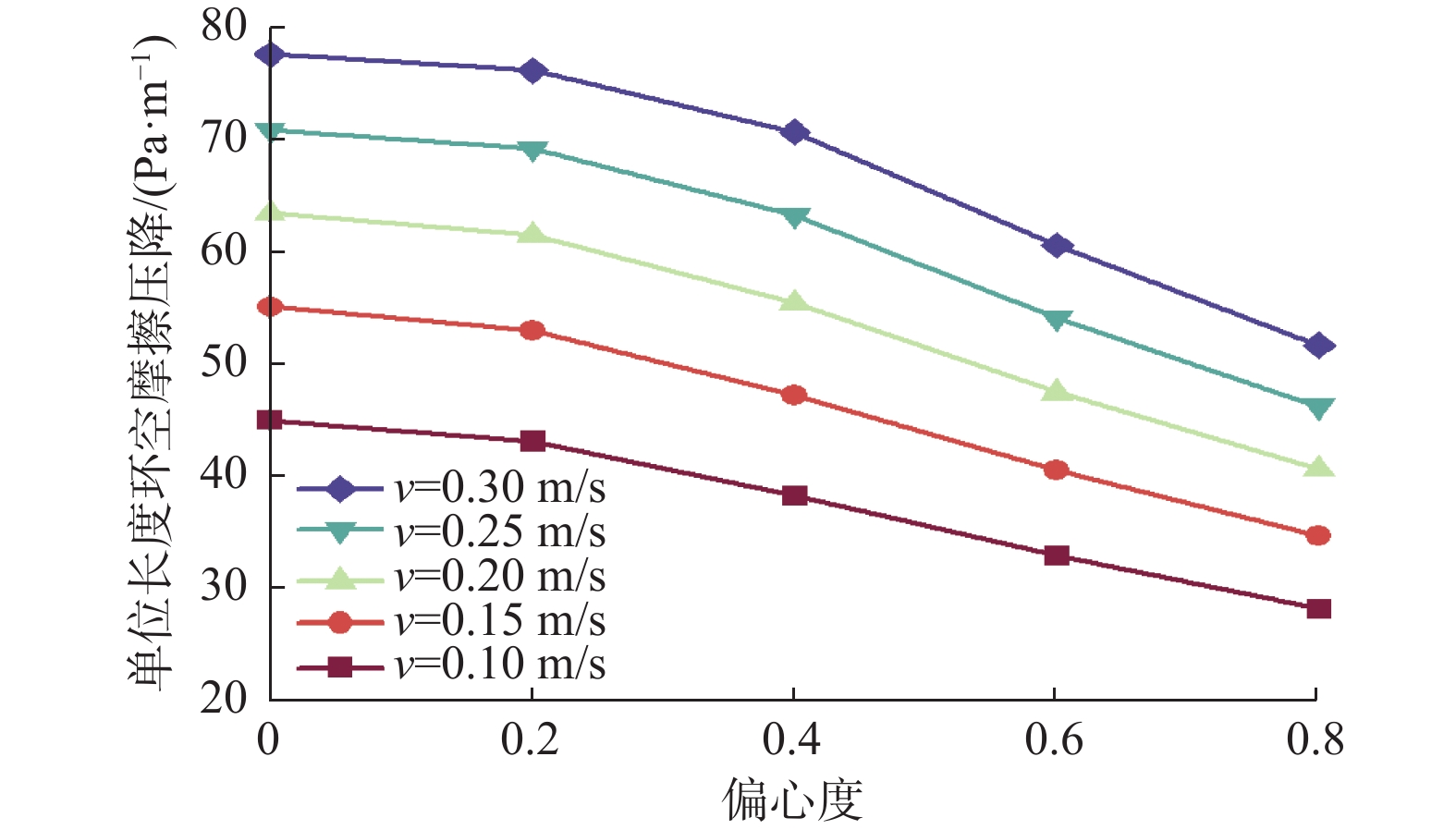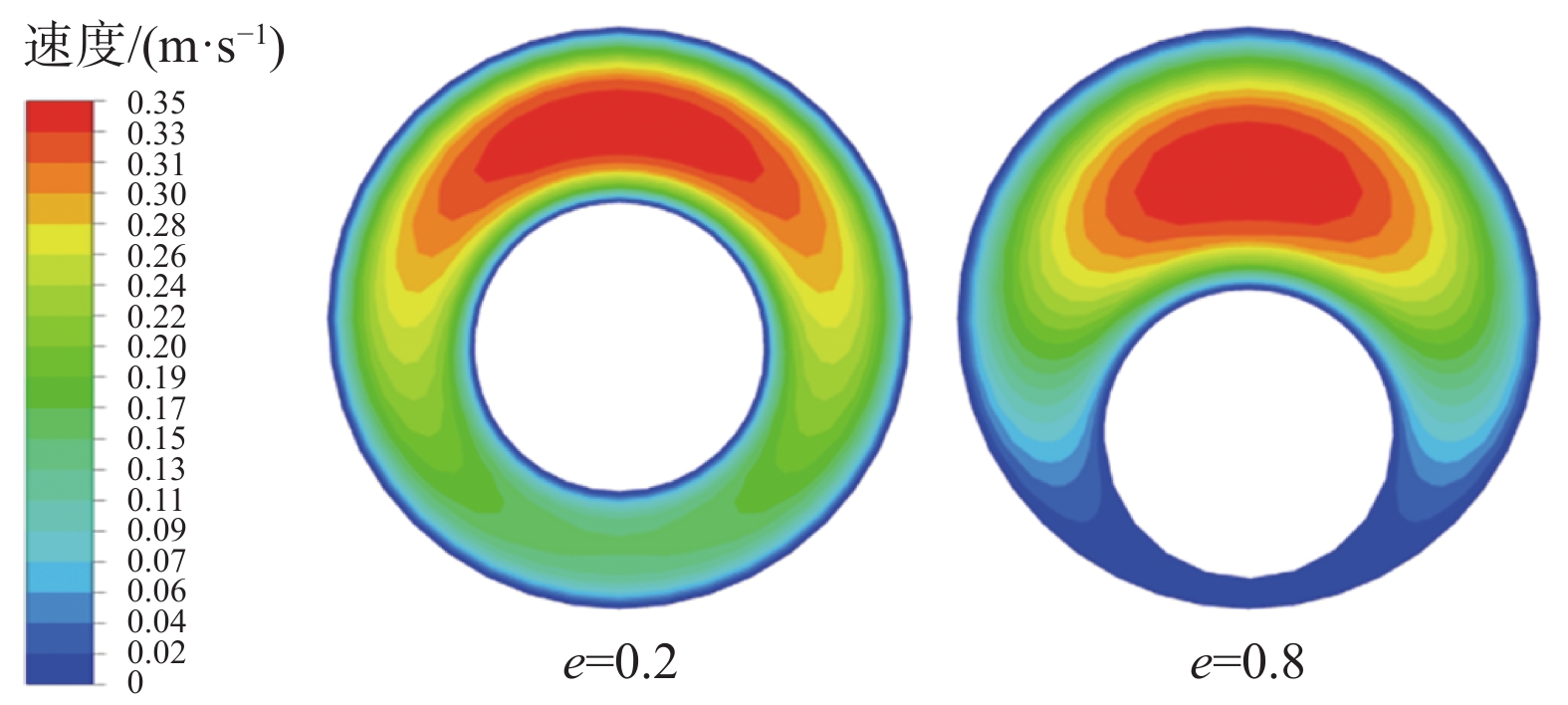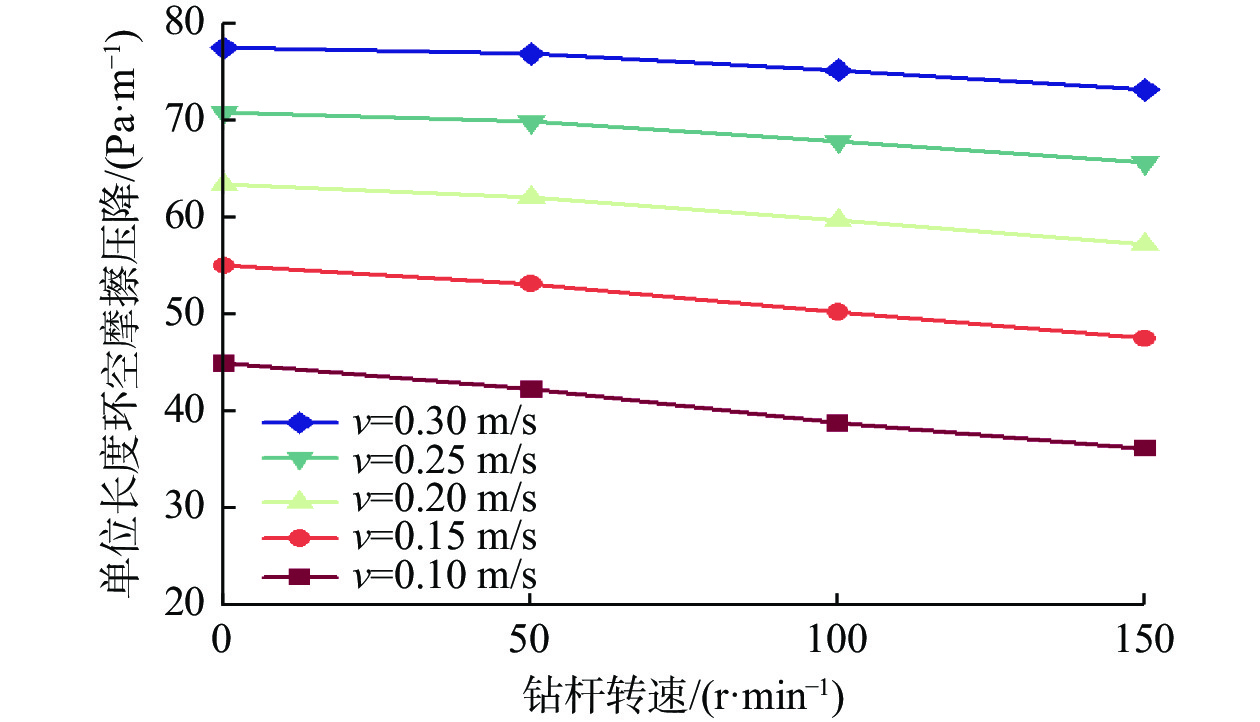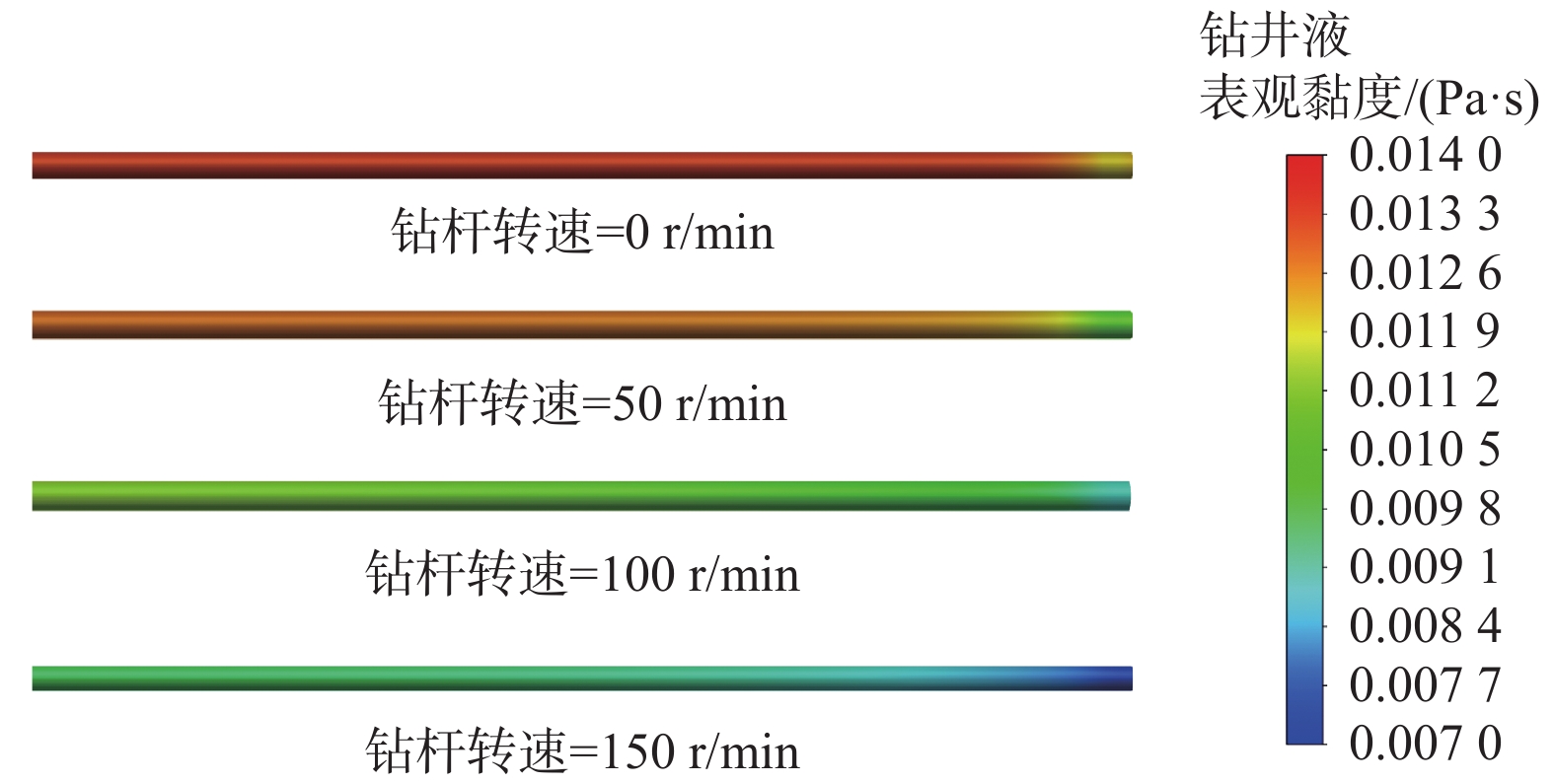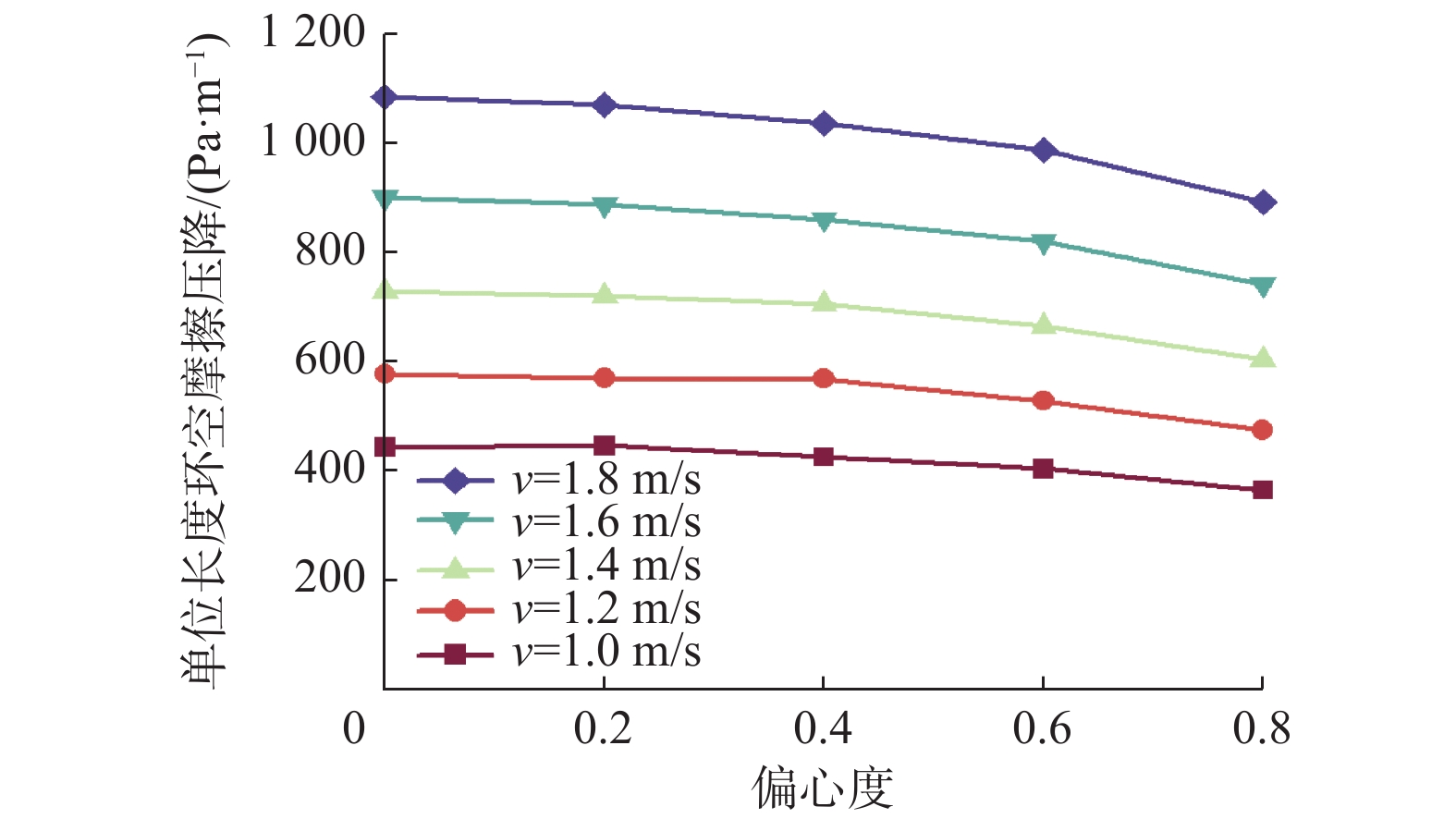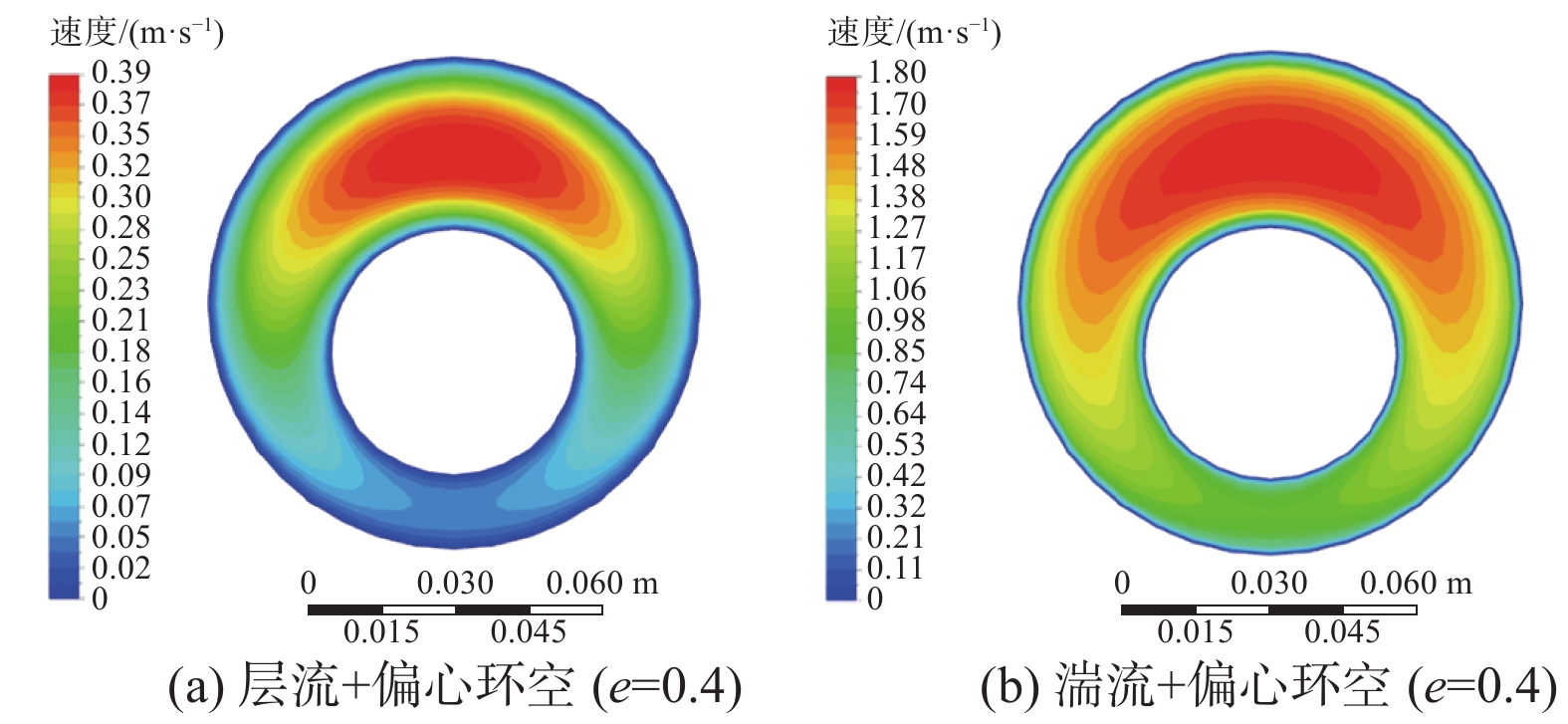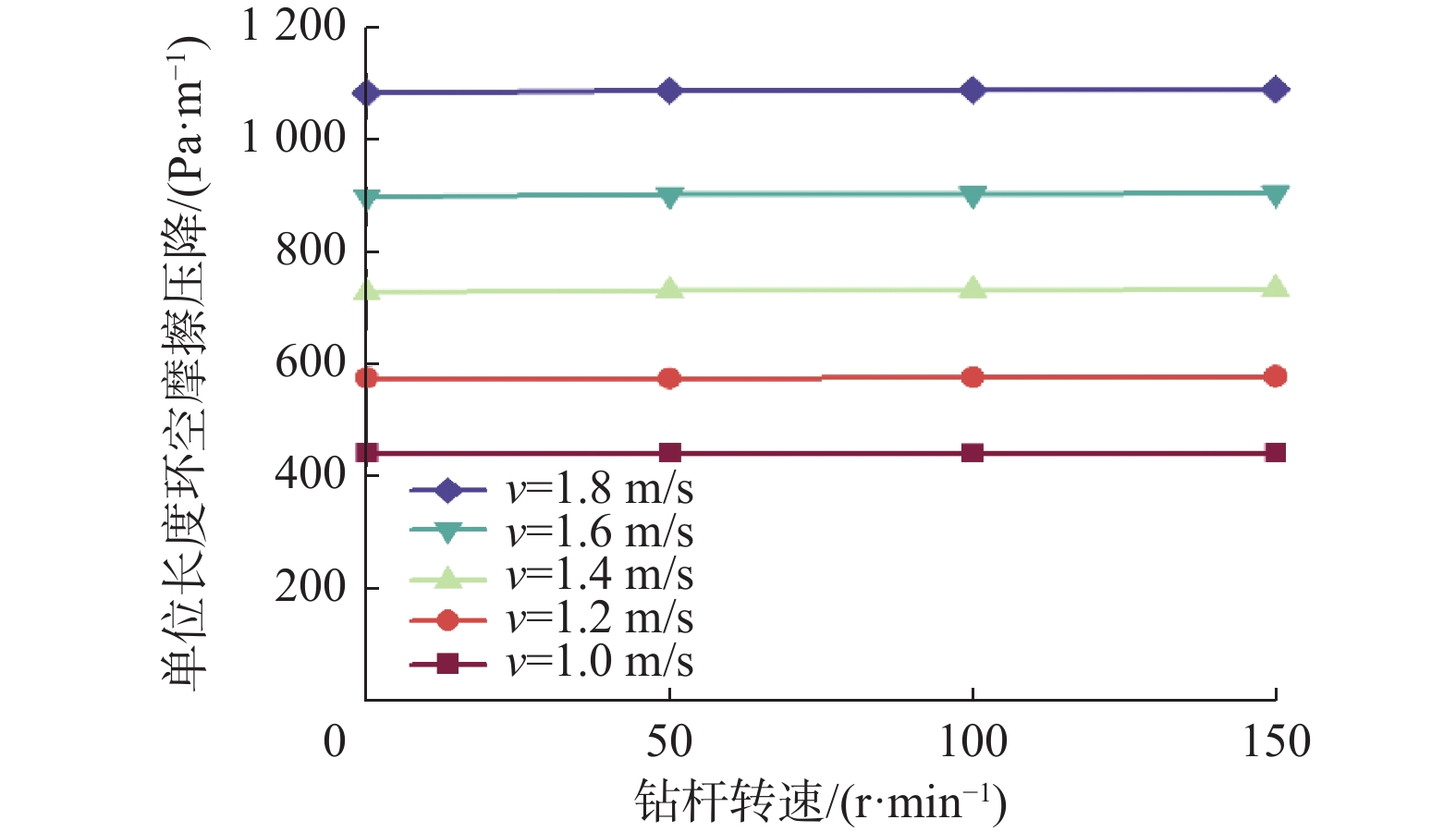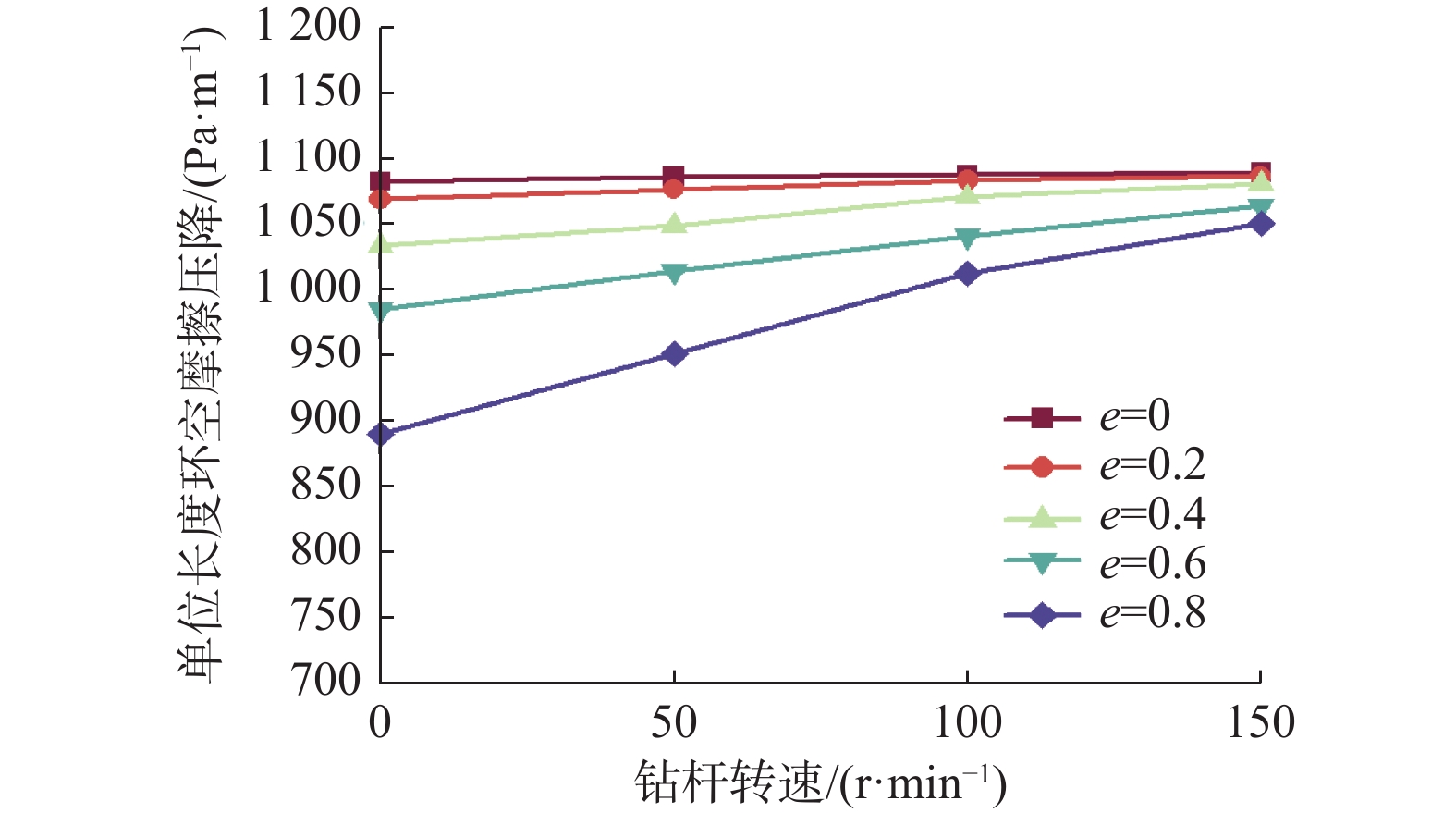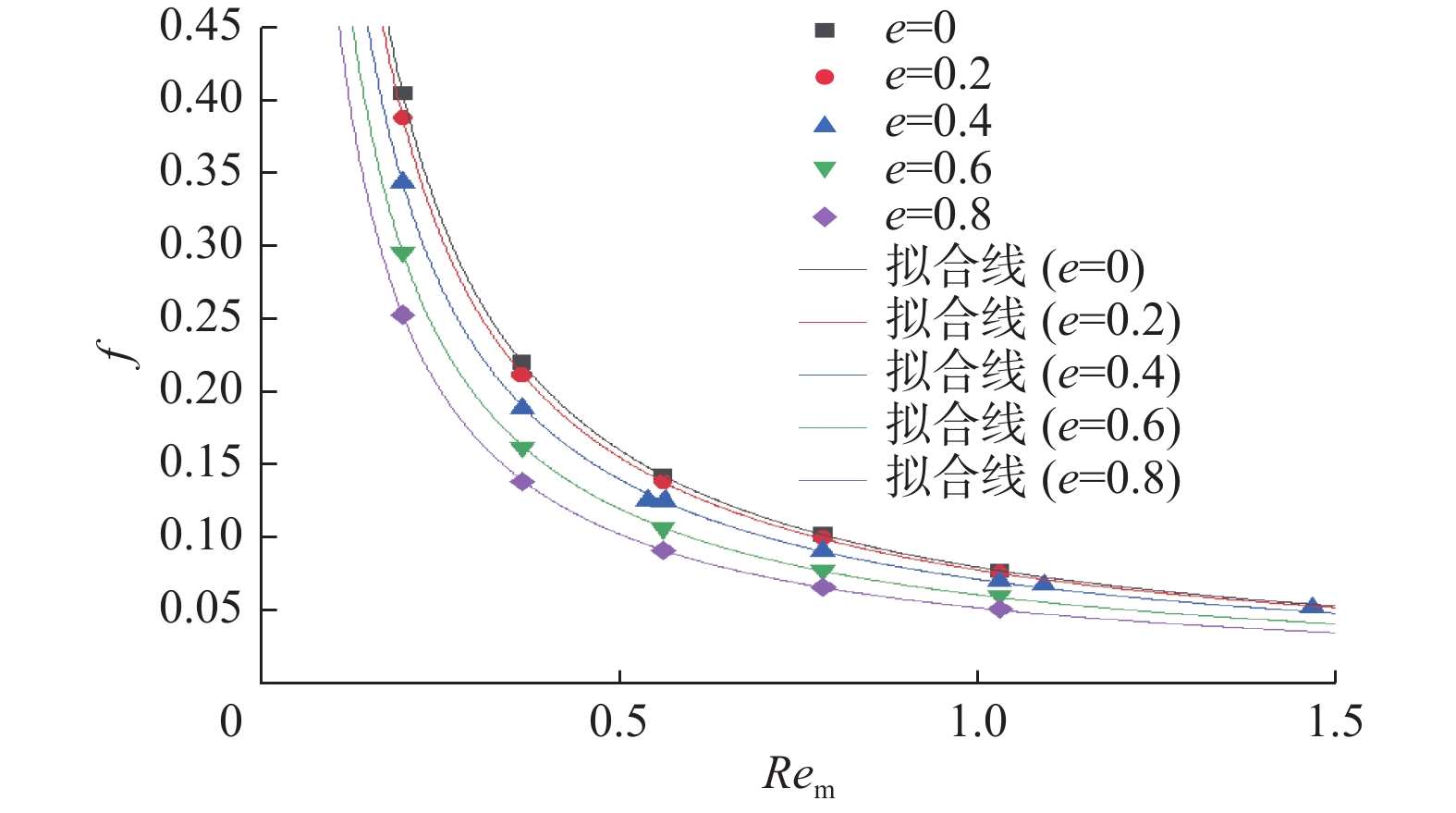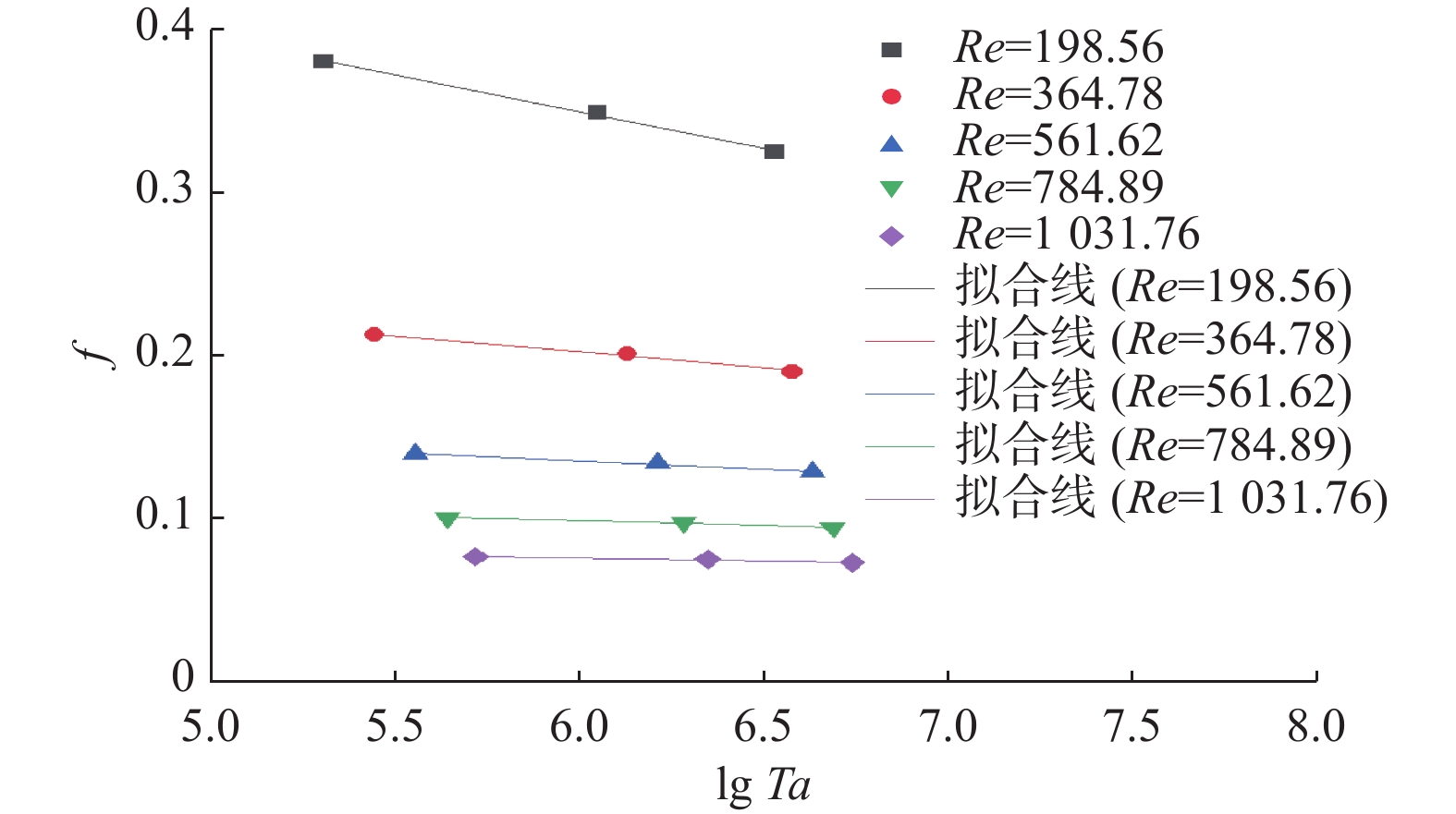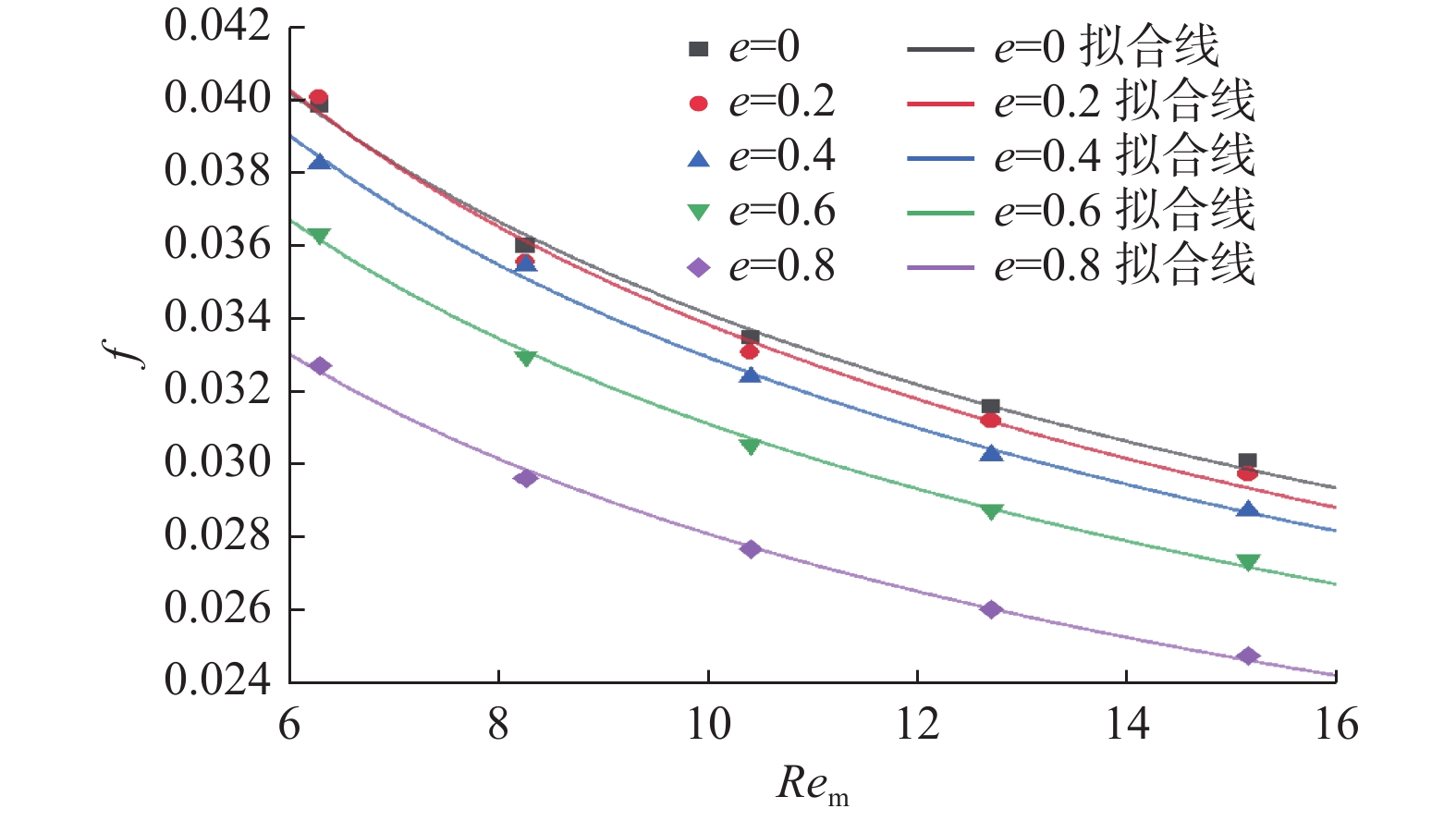CFD Simulation and Prediction Model of Annular Frictional Pressure Drop with Combined Effects of Drillpipe Rotation Speed and Eccentricity
-
摘要:
深井钻井时,准确预测环空摩擦压降是保证井筒压力预测精度的关键,钻井液流速、钻杆转速及环空偏心度是影响环空摩擦压降的重要因素。为研究多种因素耦合作用下环空摩擦压降的变化规律,建立了水平井环空钻井液流动模型,对幂律流体在层流和湍流条件下的流动特性开展了数值模拟。模拟结果表明:层流状态下,偏心度和钻杆转速单独作用时,都会导致环空摩擦压降减小;偏心度和钻杆转速共同作用时,环空摩擦压降随偏心度先增大后减小,这与偏心环空中惯性效应对螺旋流的破坏作用有关。湍流状态下,钻杆转速对同心环空的摩擦压降几乎没有影响;偏心环空中,随着钻杆转速增大,不同偏心度下的环空摩擦压降值逐渐增加,且都逐渐趋近于同心环空摩擦压降。基于数值模拟数据,建立了层流和湍流条件下考虑钻杆转速和偏心度耦合作用的环空摩擦因子预测模型,该模型对模拟数据的最大拟合误差为9.18%,对试验数据的最大预测误差为8.33%。研究结果可为深井钻井时井筒压力控制和水力参数优化提供参考。
Abstract:Accurate prediction of annular frictional pressure drop is the key to ensuring the accuracy of bottomhole pressure prediction during deep well drilling. The flow rate of the drilling fluid, drillpipe rotation speed, and the annular eccentricity are important factors affecting the annular frictional pressure drop. To investigate the change in annular frictional pressure drop with the combined effects of various factors, a drilling fluid flow model in the annulus of a horizontal well was developed, and the flow characteristics of power-law fluids under laminar and turbulent flow conditions were numerically investigated. The results show that: 1) under the laminar flow condition, annular frictional pressure drop decreases when the eccentricity or the drillpipe rotation speed increases separately. However, when these two parameters increase simultaneously, the annular frictional pressure drop increases first and then decreases as eccentricity increases. This is due to the destruction of helical flow by the inertia effect in the eccentric annulus. 2) Under the turbulent flow condition, drillpipe rotation speed has almost no effects on the frictional pressure drop in the concentric annulus. In the eccentric annulus, with the drillpipe rotation speed increasing, the frictional pressure drop under different eccentricities increases gradually and converges to the frictional pressure drop in the concentric annulus. Based on the numerical simulation data, the prediction model for annular frictional coefficient with the combined effects of drillpipe rotation speed and eccentricity under laminar and turbulent flow conditions are developed. The maximum fitting error of the model to the simulated data is 9.18%, and the prediction error for experimental data is no more than 8.33%. The results of this study could provide reference for wellbore pressure control and hydraulic parameter optimization during deep well drilling.
-
-
表 1 网格无关性分析结果
Table 1 Mesh independence analysis
网格划分
方案网格数 总网格数 单位长度环空摩擦
压降/(Pa·m−1)轴向 径向 周向 1 180 8 24 34 560 759.77 2 240 10 32 76 800 730.67 3 360 10 40 144 000 720.51 4 480 16 48 368 640 719.56 5 500 20 52 520 000 718.78 表 2 数值模拟方案
Table 2 Scheme of numerical simulation
稠度系数/
(Pa·sn)流性指数 入口速度/
(m·s−1)偏心度 钻杆转速/
(r·min−1)0.10 0.50 层流:0.10, 0.15,
0.20, 0.25, 0.30
湍流:1.00, 1.20,
1.40, 1.60, 1.800, 0.2, 0.4,
0.6, 0.80, 50, 100, 150 2.10 0.38 层流:1.00
湍流:4.000.4 0, 100 0.83 0.56 0.37 0.59 0.25 0.61 表 3 偏心度与公式(16)中a1和a2的关系
Table 3 The relationship between Reynolds number and a1, a2 in Eq. 16
e a1 a2 0 0.08017 −1.00121 0.2 0.07819 −0.99010 0.4 0.07179 −0.96671 0.6 0.06114 −0.97408 0.8 0.05223 −0.97522 表 4 R.M.Ahmed等人和M.Sorgun等人在试验中的环空尺寸及钻井液流变性参数
Table 4 Annulus dimensions and rheological properties of drilling fluids in experiments of R.M.Ahmed and M.Sorgun
-
[1] 苏义脑,路保平,刘岩生,等. 中国陆上深井超深井钻完井技术现状及攻关建议[J]. 石油钻采工艺,2020,42(5):527–542. SU Yinao, LU Baoping, LIU Yansheng, et al. Status and research suggestions on the drilling and completion technologies for onshore deep and ultra deep wells in China[J]. Oil Drilling & Production Technology, 2020, 42(5): 527–542.
[2] 李阳,薛兆杰,程喆,等. 中国深层油气勘探开发进展与发展方向[J]. 中国石油勘探,2020,25(1):45–57. LI Yang, XUE Zhaojie, CHENG Zhe, et al. Progress and development directions of deep oil and gas exploration and development in China[J]. China Petroleum Exploration, 2020, 25(1): 45–57.
[3] 余意,王雪瑞,柯珂,等. 极地钻井井筒温度压力预测模型及分布规律研究[J]. 石油钻探技术,2021,49(3):11–20. YU Yi, WANG Xuerui, KE Ke, et al. Prediction model and distribution law study of temperature and pressure of the wellbore in drilling in Arctic region[J]. Petroleum Drilling Techniques, 2021, 49(3): 11–20.
[4] AHMED R M, MISKA S Z. Experimental study and modeling of yield power-law fluid flow in annuli with drillpipe rotation[R]. SPE 112604, 2008.
[5] ERGE O, OZBAYOGLU E M, MISKA S Z, et al. Equivalent circulating density modeling of Yield Power Law fluids validated with CFD approach[J]. Journal of Petroleum Science and Engineering, 2016, 140: 16–27. doi: 10.1016/j.petrol.2015.12.027
[6] 赵岩. 非牛顿流体偏心环空螺旋流的CFD模拟[D]. 杭州: 中国计量大学, 2017. ZHAO Yan. Non-Newtonian fluid in eccentric annulus helical flow field of the CFD simulation[D]. Hangzhou: China Jiliang University, 2017.
[7] 蔡萌. 幂律流体偏心环空螺旋流压力梯度的数值计算[J]. 石油钻采工艺,2010,32(2):11–14. CAI Meng. Numerical calculation of pressure gradient of helical flow of power-law fluid in eccentric annulus[J]. Oil Drilling & Production Technology, 2010, 32(2): 11–14.
[8] MCCANN R C, QUIGLEY M S, ZAMORA M, et al. Effects of high-speed pipe rotation on pressures in narrow annuli[J]. SPE Drilling & Completion, 1995, 10(2): 96–103.
[9] KELESSIDIS V C, MAGLIONE R, TSAMANTAKI C, et al. Optimal determination of rheological parameters for Herschel–Bulkley drilling fluids and impact on pressure drop, velocity profiles and penetration rates during drilling[J]. Journal of Petroleum Science and Engineering, 2006, 53(3/4): 203–224.
[10] PILEHVARI A, SERTH R. Generalized hydraulic calculation method for axial flow of non-Newtonian fluids in eccentric annuli[J]. SPE Drilling & Completion, 2009, 24(4): 553–563.
[11] ERGE O, OZBAYOGLU E M, MISKA S Z, et al. The effects of drillstring-eccentricity, -rotation, and -buckling configurations on annular frictional pressure losses while circulating yield-power-law fluids[J]. SPE Drilling & Completion, 2015, 30(3): 257–271.
[12] SORGUN M, OZBAYOGLU M E, AYDIN I. Modeling and experimental study of Newtonian fluid flow in annulus[J]. Journal of Energy Resources Technology, 2010, 132(3): 033102. doi: 10.1115/1.4002243
[13] FOUNARGIOTAKIS K, KELESSIDIS V C, MAGLIONE R. Laminar, transitional and turbulent flow of Herschel–Bulkley fluids in concentric annulus[J]. The Canadian Journal of Chemical Engineering, 2008, 86(4): 676–683. doi: 10.1002/cjce.20074
[14] SAASEN A. Annular frictional pressure losses during drilling—predicting the effect of drillstring rotation[J]. Journal of Energy Resources Technology, 2014, 136(3): 034501. doi: 10.1115/1.4026205
[15] 贺成才. 幂律流体同心环空螺旋流数值模拟[J]. 钻井液与完井液,2002,19(4):7–9. HE Chengcai. Numerical modeling of the power-law fluid in a helical flow[J]. Drilling Fluid & Completion Fluid, 2002, 19(4): 7–9.
[16] NOURI J M, WHITELAW J H. Flow of Newtonian and non-Newtonian fluids in an eccentric annulus with rotation of the inner cylinder[J]. International Journal of Heat and Fluid Flow, 1997, 18(2): 236–246. doi: 10.1016/S0142-727X(96)00086-0
[17] FERROUDJI H, HADJADJ A, HADDAD A, et al. Numerical study of parameters affecting pressure drop of power-law fluid in horizontal annulus for laminar and turbulent flows[J]. Journal of Petroleum Exploration and Production Technology, 2019, 9(4): 3091–3101. doi: 10.1007/s13202-019-0706-x
[18] SALUBI V, MAHON R, OLUYEMI G. The combined effect of fluid rheology, inner pipe rotation and eccentricity on the flow of Newtonian and non-Newtonian fluid through the annuli[J]. Journal of Petroleum Science and Engineering, 2022, 211: 110018. doi: 10.1016/j.petrol.2021.110018
[19] COLEMAN B D, NOLL W. Helical flow of general fluids[J]. Journal of Applied Physics, 1959, 30(10): 1508–1512. doi: 10.1063/1.1734990
[20] OZBAYOGLU E M, SORGUN M. Frictional pressure loss estimation of non-Newtonian fluids in realistic annulus with pipe rotation[J]. Journal of Canadian Petroleum Technology, 2010, 49(12): 57–64. doi: 10.2118/141518-PA
[21] 翟科军,于洋,何浪,等. 幂律流体螺旋层流流动压降简化模型[J]. 石油机械,2020,48(10):10–15. ZHAI Kejun, YU Yang, HE Lang, et al. Simplified pressure drop model for laminar helical flow of power law fluid[J]. China Petroleum Machinery, 2020, 48(10): 10–15.
[22] SAYINDLA S, LUND B, YTREHUS J D, et al. CFD modeling of hydraulic behavior of oil- and water-based drilling fluids in laminar flow[J]. SPE Drilling & Completion, 2019, 34(3): 207–215.
[23] 张晋凯,李根生,黄中伟,等. 不同偏心度的环空涡动流场特性[J]. 石油钻采工艺,2016,38(2):133–137. ZHANG Jinkai, LI Gensheng, HUANG Zhongwei, et al. Features of vortex flow fields in annuluses with different eccentricities[J]. Oil Drilling & Production Technology, 2016, 38(2): 133–137.
[24] HACIISLAMOGLU M, LANGLINAIS J. Non-Newtonian flow in eccentric annuli[J]. Journal of Energy Resources Technology, 1990, 112(3): 163–169. doi: 10.1115/1.2905753
[25] 王常斌,陈皖,田迪,等. 幂律流体偏心环空流场的CFD模拟[J]. 钻井液与完井液,2009,26(3):62–64. WANG Changbin, CHEN Wan, TIAN Di, et al. A CFD simulation of the flow field of a power law fluid in an eccentric annulus[J]. Drilling Fluid & Completion Fluid, 2009, 26(3): 62–64.
[26] 蒋世全. 牛顿流体条件下偏心环空间隙雷诺数及层流区域方程研究[J]. 中国海上油气,2007,19(6):398–401. JIANG Shiquan. The study of eccentric annular clearance Reynolds number and laminar flow area equation under Newtonian fluid condition[J]. China Offshore Oil and Gas, 2007, 19(6): 398–401.
[27] PATEL D. Modification of generalized hydraulic calculation method for non-Newtonian fluids in eccentric annuli[D]. Kingsville, Texas: Texas A & M University-Kingsville, 2006.
[28] DOKHANI V, MA Yue, LI Zili, et al. Effects of drill string eccentricity on frictional pressure losses in annuli[J]. Journal of Petroleum Science and Engineering, 2020, 187: 106853. doi: 10.1016/j.petrol.2019.106853
[29] SULTAN R A, RAHMAN M A, RUSHD S, et al. CFD analysis of pressure losses and deposition velocities in horizontal annuli[J]. International Journal of Chemical Engineering, 2019, 2019: 7068989.
[30] 宋先知,李根生,王梦抒,等. 连续油管钻水平井岩屑运移规律数值模拟[J]. 石油钻探技术,2014,42(2):28–32. SONG Xianzhi, LI Gensheng, WANG Mengshu, et al. Numerical simulation on cuttings carrying regularity for horizontal wells drilled with coiled tubing[J]. Petroleum Drilling Techniques, 2014, 42(2): 28–32.
[31] MADLENER K, FREY B, CIEZKI H. Generalized Reynolds number for non-Newtonian fluids[J]. Progress in Propulsion Physics, 2009, 1: 237–250.
[32] AYENI K, OSISANYA S O. Evaluation of commonly used fluid rheological models using developed drilling hydraulic simulator[R]. PETSOC−2004−039, 2004.
[33] VIEIRA NETO J L, MARTINS A L, ATAÍDE C H, et al. The effect of the inner cylinder rotation on the fluid dynamics of non-Newtonian fluids in concentric and eccentric annuli[J]. Brazilian Journal of Chemical Engineering, 2014, 31(4): 829–838. doi: 10.1590/0104-6632.20140314s00002871
[34] SORGUN M, OZBAYOGLU M E. Predicting frictional pressure loss during horizontal drilling for non-Newtonian fluids[J]. Energy Sources, Part A: Recovery, Utilization, and Environmental Effects, 2011, 33(7): 631–640. doi: 10.1080/15567030903226264
-
期刊类型引用(10)
1. 戴文潮,刘奔. 高性能底封拖动分段压裂工具研制及试验. 钻采工艺. 2023(01): 120-125 .  百度学术
百度学术
2. 谢斌,陈超峰,马都都,练章华,史君林. 超深高温高压井尾管悬挂器安全性评价新方法. 天然气工业. 2022(09): 93-101 .  百度学术
百度学术
3. 郭朝辉,李振,罗恒荣. Φ273.1mm无限极循环尾管悬挂器在元坝气田的应用研究. 石油钻探技术. 2021(05): 64-69 .  本站查看
本站查看
4. 古青,宋剑鸣,曹博,马淼,蒋立坤,杨旭,冯治锋. 高温高压尾管悬挂器研制与应用. 石油矿场机械. 2021(06): 51-57 .  百度学术
百度学术
5. 高果成. 内嵌卡瓦尾管悬挂器在老井侧钻中的优势综合分析. 钻采工艺. 2020(01): 77-80+12 .  百度学术
百度学术
6. 马开华,谷磊,叶海超. 深层油气勘探开发需求与尾管悬挂器技术进步. 石油钻探技术. 2019(03): 34-40 .  本站查看
本站查看
7. 朱晓丽,张金法,魏书雷. 尾管用内嵌式卡瓦坐挂机构承载能力分析. 石油矿场机械. 2018(05): 84-87 .  百度学术
百度学术
8. 马兰荣,达伟,韩峰,张瑞. 高性能尾管悬挂器关键技术. 断块油气田. 2017(06): 859-862 .  百度学术
百度学术
9. 刘珂兵,贾彪,王庆,黄煜鹏. 关于内嵌卡瓦尾管悬挂器的应用探讨. 中国石油和化工标准与质量. 2016(22): 74-75 .  百度学术
百度学术
10. 韩峰,崔晓杰,薛占峰,邓同军. 悬挂器坐挂引起的套管二维屈曲失效形式研究. 中国科技论文. 2016(23): 2696-2699+2710 .  百度学术
百度学术
其他类型引用(1)




 下载:
下载:
